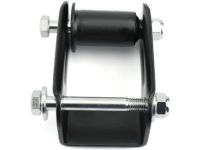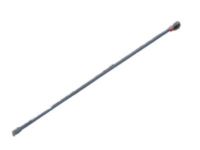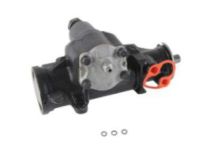Why choose GMPartsGiant
- Optimal Shopping Experience
Want to buy parts for your GMC Sonoma? Look no further than GMPartsGiant.com, the best place for GMC Sonoma genuine parts. For years, all of our GMC Sonoma auto parts and accessories have been expedited directly from dedicated dealers and backed by the manufacturer's warranty, so buying from GMPartsGiant.com is always risk-free.
- Dedicated Customer Service
Our first-class customer service team is committed to providing you with the best assistance possible. Dedicated representatives are standing by to assist you by email, live chat, or phone. Every effort is made to ensure your order for OEM GMC Sonoma parts arrives fast no matter your location in the nation, so your vehicle is up and running and back on the road.
- Unbeatable Prices
What makes us the best online source for GMC Sonoma parts and GMC Sonoma truck parts? Our goal is to offer the lowest prices. You get giant savings shopping with GMPartsGiant.com. With a complete GMC Sonoma parts catalog, we cover a full selection of affordable OEM GMC Sonoma parts and pickup parts with a huge inventory.
Popular Genuine GMC Sonoma Parts
- Engine Parts View More >
- Fuel System, Exhaust, Emission System Parts View More >
- Brakes Parts View More >
- Transmission - Automatic Parts View More >
- Frames, Springs, Shocks, Bumpers Parts View More >
- Cooling System, Grille, Oil System Parts View More >
- Front Axle, Front Suspension, Steering Parts View More >
- Front End Sheet Metal, Heater Parts View More >
Shop Genuine GMC Sonoma Parts with GMPartsGiant.com
The GMC Sonoma, produced from 1982 to 2005, was a popular compact pickup truck, distinguished as one of the first light pickups crafted by the major American automakers in response to the 1970s oil crisis. Introduced as part of the S series, the Sonoma underwent numerous enhancements throughout its production life, earning it a reputation for versatility and durability. A year after its launch, the truck was updated with the Insta-Trac four-wheel drive and an extended cab version, increasing its utility. Several luxury options, including the Sierra version, were also introduced, further widening the truck's appeal. In 1984, enhancements included a hydraulic clutch and a reinforced suspension, which contributed to the vehicle's reliability and driving comfort. A major highlight was the introduction of the GT sports version in 1992, featuring a 4.3-liter Vortec V6 engine, capable of delivering 165 horsepower while maintaining its towing and hauling capabilities. With its aerodynamic package and premium interior touches, the GT became a favorite among performance truck enthusiasts. The second generation, introduced in 1994, offered a standard 2.2L four-cylinder engine producing 118 hp, alongside a more powerful 4.3L V6 variant. In 2001, a significant redesign saw the introduction of a four-door version with seating for five, consolidating the Sonoma as a flexible and capable pickup. Despite discontinuation in 2004, the Sonoma still enjoys a strong reputation for its adaptability and robustness, evident in its continued use and positive industry reviews.
The GMC Sonoma, particularly the 2001 model, has been plagued by two primary concerns affecting the safety and reliability of the vehicle. Firstly, there have been frequent reports of airbags not deploying during crucial times, such as accidents. This critical safety feature, intended to shield passengers during collisions, has failed for reasons that include computer activation errors, defective crash sensors, failing to replace airbags after they've been deployed in previous incidents, and broader issues within the airbag module itself. These problems could originate from manufacturing errors, damaged electrical components, or inadequate maintenance. The consequences of non-deployment are dire, significantly raising the likelihood of severe injuries to areas like the chest, neck, back, face, limbs, and even internal organs. Some instances, such as when a 2001 GMC Sonoma traveling at 45 mph rear-ended another vehicle, and another separate incident involving brake failure, both resulted in the airbags not deploying. Such cases underscore the concerns regarding the vehicle's airbag system's safety and reliability. Affected parties might qualify for compensation covering aspects like medical costs, suffering, lost wages, etc. A comprehensive investigation can identify the malfunction's root cause, potentially leading to claims against responsible parties, whether the car manufacturer or the airbag producers. Secondly, the GMC Sonoma recurrently grapples with the windshield unexpectedly fogging up, hindering the driver's view and putting road safety in jeopardy. This phenomenon mainly emerges from the car's internal humidity, linked to sources like passengers' breath, damp clothing, or wet items in the car. To tackle this, it's recommended to consistently clean the interior windows, particularly during humid seasons, because dust and oil accumulation can amplify fogging by holding moisture. Managing the car's interior moisture is vital; in winters, actions like shaking off snow from clothes or using dehumidifying crystals can help. Using the car's defogger or defroster, which works by pulling external air into the interior, is an effective strategy against such fogging. While the 'recirculate' function warms the car more rapidly, it traps moisture inside. Thus, introducing drier outside air by slightly opening the windows or leveraging the air system is advisable. Preheating the car and switching on the defroster prior to fog emergence is also helpful, but caution is warranted to prevent carbon monoxide exposure in confined spaces. In urgent situations, a quick wipe with a dry cloth can offer momentary clarity, and the defoggers, by warming the glass, deter fog creation. Furthermore, when external fog comes into play, caused by airborne water droplets, it can obscure driving visibility, making it difficult to spot traffic indicators or unexpected road hazards. Such circumstances might also lead to slick roads due to moisture or ice. Under these conditions, drivers should reduce their speed, use low-beam headlights, turn on any available fog lights, utilize the right pavement marking as guidance, refrain from halting on roads, maintain a safe following distance, employ windshield wipers and defrosters for an unobstructed view, and avoid cruise control to remain alert to abrupt changes in road conditions.
To achieve maximum perfection, OEM parts are manufactured and tested in accordance with GMC's official factory standards. Welcome to your ultimate destination for affordable OEM GMC Sonoma parts, like Transmission - Manual, Rear Body Structure, Moldings & Trim, Cargo Stowage. Here at our website, we not only provide genuine GMC Sonoma parts, such as Transfer Case at unbeatable prices, but also guarantee their quality with the manufacturer's warranty. Coupled with our dedicated customer service and swift delivery, we're confident you won't find a better deal anywhere else.
GMC Sonoma Parts Questions & Answers
- Q: How do you remove and replace the leaf springs and Leaf Spring Shackle on GMC Sonoma?A: To remove and replace the leaf springs on a vehicle, start by raising the rear of the vehicle and supporting it securely on jack stands. Block the front wheels to prevent the vehicle from rolling off the stands. Use a floor jack to support the axle and raise it slightly to relieve tension on the leaf springs. Remove the four U-bolt nuts and washers, followed by the anchor plate and U-bolts with a spacer. Raise the axle slightly off the springs with the floor jack. If the spring will be removed for an extended period, support the axle with jack stands. To reinstall, reverse the removal steps, gradually tightening the U-bolt nuts in a crisscross pattern and then tightening all fasteners to the specified torque. If the bushings at the ends of the spring are worn or deteriorated, they can be pressed out and replaced with new ones.
- Q: How to remove the torsion bar on GMC Sonoma?A: To remove the torsion bar, first loosen the lug nuts of the front wheels and then lift up the car with jackstands. Take off the wheel and count how many threads are visible on the torsion bar adjuster bolt, indicating where he bolt is in relation to the nut for adjustment. Place a small push puller on dimple of adjuster arm and turn bolt until there is no tension, then remove adjusting nut. Note where torsion bar attaches to lower control arm and slide bar forward through arm until rear end clears cross member. Remove adjuster arm and pull down and back on torsion bar. If front of suspension hangs up in control arm, drive out with brass drift. Install by cleaning out lubricating hexagonal hole in control arm and greasing ends of torsion bars as well as adjuster arms and bolts. Ensure that marks match up correctly, tighten up the adjusting bolt so that equal number threads can be seen again. Measure clearance between arm and cross-member then set torsion bar accordingly as need arises. Put on wheel, let vehicle down while tightening lug nuts securely and finally find ride height at each side of vehicle's body before leveling it using torsion bars.
- Q: How do you remove the steering gear on GMC Sonoma?A: To remove the rack and pinion, start by raising the front of the vehicle and supporting it securely on jackstands. Disconnect the power steering hose fittings and cap the ends to prevent fluid loss and contamination. Pry apart the U-joint plastic shield and remove it, marking the relationship of the intermediate shaft lower universal joint to the rack and pinion input shaft. Remove the intermediate shaft lower pinch bolt and disconnect the Pitman arm from the relay rod. Support the rack and pinion, remove the mounting bolts, and lower the unit. Separate the intermediate shaft from the rack and pinion input shaft and remove the rack and pinion from the vehicle. To install the rack and pinion, slide the Pitman arm onto the shaft, aligning the marks, and tighten the nut to the proper torque. Raise the rack and pinion and Pitman arm into position, connecting the intermediate shaft and aligning the marks. Install the mounting bolts and tighten them to the correct torque specifications. Install the lower intermediate shaft pinch bolt and the plastic shield. Connect the power steering hose fittings and fill the power steering pump reservoir with the recommended fluid. Finally, lower the vehicle and bleed the steering system.
- Q: How do you remove the accelerator cable on GMC Sonoma?A: To remove the throttle cable, start by detaching the screws and clip retaining the lower instrument panel trim and lowering the trim. Then, detach the throttle cable from the accelerator pedal by squeezing the cable cover tangs and pushing the cable through the firewall into the engine compartment. Next, rotate the throttle lever and detach the throttle cable from the throttle lever. Finally, squeeze the throttle cable retaining tangs and push the cable through the throttle cable bracket. To install the throttle cable, simply reverse the removal steps. Make sure to operate the accelerator pedal and check for any binding condition by completely opening and closing the throttle. Additionally, apply sealant around the throttle cable at the engine compartment side of the firewall.





















































